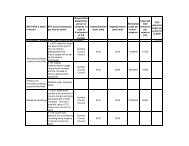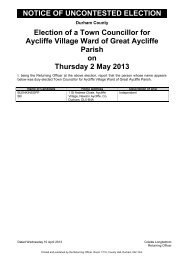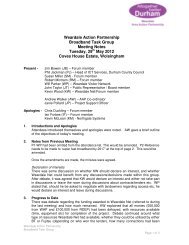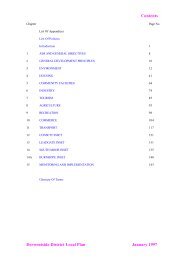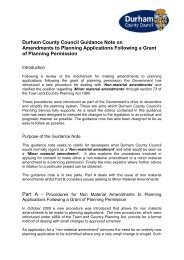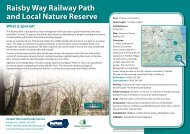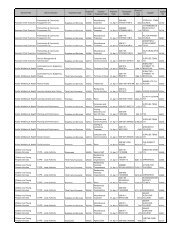SECTION 3.0 - Durham County Council
SECTION 3.0 - Durham County Council
SECTION 3.0 - Durham County Council
You also want an ePaper? Increase the reach of your titles
YUMPU automatically turns print PDFs into web optimized ePapers that Google loves.
DESIGNATED SITES:<br />
PPS9 states that LDF’s should indicate the location of designated sites of<br />
importance for biodiversity and geodivers ity, making clear distinctions between the<br />
hierarchy of international, national, regional<br />
and locally designated sites.<br />
There are a number of designations, which relate<br />
specifically to ecological and geological<br />
conservation. These designations are categorised<br />
as those of international, national or<br />
local importance. Some sites are covered by more than one type of designation, such as<br />
the North Pennines AONB. Designations app lied to ecological and geological features may<br />
be of international, national, or regional and local importance. Those relevant to the county<br />
are<br />
listed below, with the hierarchical structure of international through to local<br />
representing the relative<br />
weight or importance placed on each resource.<br />
The northeast has a relatively high proportion o f designated sites, 30% of the total area, as<br />
opposed to 8% nationally. The region also has the highest proportion of SSSI’s with geo-<br />
features in favourable condition at 91%. The Moorhouse/Upper<br />
Teasdale is the largest of<br />
the 3 English Biosphere reserves at 7149ha.<br />
The North Pennines Geopark shares a boundary<br />
with the AONB across <strong>County</strong> <strong>Durham</strong>,<br />
Cumbria and Northumberland, and contains so me 33 geo-features. Half of the Geopark is<br />
also designated a SSSI.<br />
International designation Description<br />
RAMSAR Site A site designated as a wetland of<br />
international<br />
importance under the Ramsar<br />
Convention<br />
7<br />
Special Protection Area (SPA) A site of European importance for bird<br />
conservation,<br />
designated under the EC<br />
Birds Directive tion<br />
SPA’s are also SSSI’s.<br />
8 . Under national legisla<br />
Special Area of Conservation (SAC) Site of European conservation importance<br />
containing listed habitats or species,<br />
designated<br />
under the terms of the EC<br />
Habitats<br />
Directive<br />
le<br />
9 . Under national<br />
gislation SAC’s are also SSSI’s.<br />
7<br />
The Ramsar Convention (1971) - The Ramsar Convention on Wetlands of International Importance especially as<br />
Waterfowl Habitat was ratified by the UK in 1976. The Convention seeks to promote the conservation and wise use of<br />
wetlands, particularly those, which support internationally significant<br />
numbers of water birds. This is achieved through<br />
the designation of Ramsar Sites.<br />
8<br />
The Birds Directive (1979) - The European Community <strong>Council</strong><br />
Directive on the Conservation of Wild Birds<br />
(79/409/EEC) sets out general rules for the conservation of all naturally occurring wild birds, their nests, eggs and<br />
habitats. It requires member states to designate Special Protection<br />
Areas (SPAs) for protection of certain species.<br />
9<br />
The Habitats Directive (1992) - The European Community <strong>Council</strong> Directive on the Conservation of Natural<br />
Habitats of Wild Fauna and Flora (92/43/EEC) aims to protect the European Union's biodiversity. It requires member<br />
states to designate Special Areas of Conservation (SACs) - sit es of European importance for listed habitats and species.<br />
SACs must be maintained at, or restored to, favourable conservation<br />
status, and should be protected from damaging<br />
plans or projects<br />
Page 35 4/15/2009





